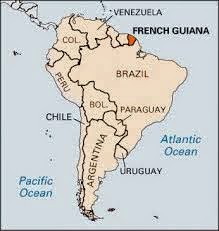French Guiana officially just Guiana, is an overseas department and region of France, on the north Atlantic coast of South America. It borders Brazil to the east and south, and Suriname to the west. Its 83,534 km2 (32,253 sq mi) area has a very low population density of only 3 inhabitants per km2, with half of its 250,109 inhabitants in 2013 living in the metropolitan area of Cayenne, its capital. By land areaoverseas region of France. As an overseas region, it is inside the European Union, and its official currency is the Euro.










, it is by far the largest
The addition of the adjective "French" in English comes from colonial times when five such colonies existed (The Guianas), namely from west to east: Spanish Guiana (now Guayana Region in Venezuela), British Guiana (now Guyana), Dutch Guiana (now Suriname), French Guiana, and Portuguese Guiana (now Amapá, a state in far northern Brazil). French Guiana and the two larger countries to the north and west, Guyana and Suriname, are still often collectively referred to as the Guianas and comprise one large shield landmass.
A large part of the department's economy derives from the presence of the Guiana Space Centre, now the European Space Agency's
launch site near the equator.
 | |
| Country | |
|---|---|
| Prefecture | Cayenne |
| Departments | 1 |
| Government | |
| • President | Rodolphe Alexandre (PSG) |
| Area | |
| • Total | 83,534 km2 (32,253 sq mi) |
| Population (Jan 2013)[1] | |
| • Total | 250,109 |
| • Density | 3.0/km2 (7.8/sq mi) |
| Demonym | French Guianese |
| Time zone | GFT (UTC-03) |
| ISO 3166 code | GF |
| GDP (2012)[2] | Ranked 27th |
| Total | €3.81 billion (US$4.90 bn) |
| Per capita | €15,416 (US$19,828) |
| NUTS Region | FR9 |
| Website | Prefecture Region Department |
As an integral part of France, French Guiana is part of the European Union and the Eurozone; its currency is the euro. .gf is the country code top-level domain (ccTLD) for French Guiana, but .fr is generally used instead.
In 2012, the GDP of French Guiana at market exchange rates was US$4.90 billion (€3.81 billion), ranking as the largest economy in the Guianas, and the 11th largest in South America.
French Guiana is heavily dependent on mainland France for subsidies, trade, and goods. The main traditional industries are fishing (accounting for 5% exports in 2012), gold mining (accounting for 32% of exports in 2012) and timber (accounting for 1% of exports in 2012). In addition, the Guiana Space Centre has played a significant role in the local economy since it was established in Kourou in 1964: it accounted directly and indirectly for 16% of French Guiana's GDP in 2002 (down from 26% in 1994, as the French Guianese economy is becoming increasingly diversified).The Guiana Space Centre employed 1,659 people in 2012.
There is very little manufacturing. Agriculture is largely undeveloped and is mainly confined to the area near the coast and along the Maroni River. Sugar and bananas were traditionally two of the main cash crops grown for export but have almost completely disappeared. Today they have been replaced bylivestock raising (essentially beef cattle and pigs) in the coastal savannas between Cayenne and Saint-Laurent-du-Maroni, and market gardening (fruits an vegetables) developed by the Hmong communities settled in French Guiana in the 1970s, both destined to the local market. A thriving rice production, developed on polders near Mana from the early 1980s to the late 2000s, has almost completely disappeared since 2011 due to marine erosion and new EU plant health rules which forbid the use of many pesticides and fertilizers. Tourism, especially eco-tourism, is growing. Unemployment is a major problem, running at about 20% to 25% year in, year out (22.3% in 2012).
In 2012, the GDP per capita of French Guiana at market exchange rates, not at PPP, was US$19,828 (€15,416), the highest in South America,[8] but only 49% of metropolitan France's average GDP per capita that year, and 57.5% of the metropolitan French regions outside the Paris Region.

